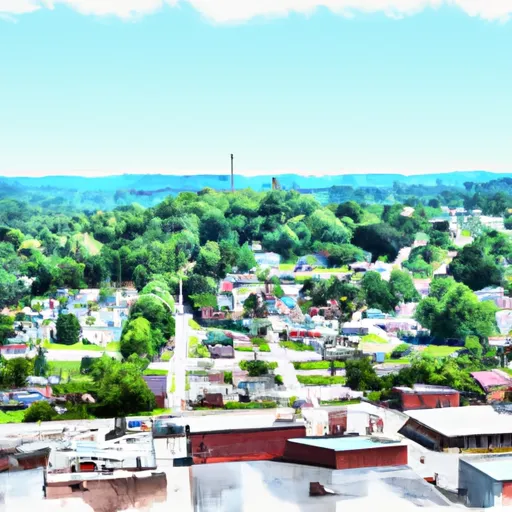-
 Snoflo Premium
Snoflo Premium
Get unlimited access to all our content
With no Ad interruptions! - Start Your Free Trial Login with existing account
Laura
Eden Index
Climate
8.2
•
Recreation
0.3
•
Community
•
Safeguard
3.4/10

Laura, Kentucky is a small town located in the southeastern part of the state. The climate in Laura is considered humid subtropical, characterized by hot summers and mild winters. Summers are typically warm and humid, with temperatures averaging in the low to mid-80s Fahrenheit. Winters are relatively mild, with temperatures averaging in the mid-30s to mid-40s Fahrenheit. Precipitation is spread throughout the year, with slightly higher amounts during the summer months.
Laura is situated near the beautiful Cumberland River, which greatly influences the hydrology of the area. The river provides a source of water for the town and offers various recreational opportunities for residents and visitors alike. Fishing is a popular activity, with anglers targeting species such as bass, crappie, and catfish. Boating and kayaking are also enjoyed along the river, providing a chance to explore the scenic surroundings.
In addition to the Cumberland River, Laura is surrounded by picturesque landscapes and rolling hills, allowing for various outdoor recreation activities. Hiking and camping are popular in the nearby forests, providing opportunities to connect with nature and enjoy the region's natural beauty. Overall, Laura, Kentucky offers a pleasant climate, abundant water resources, and diverse outdoor recreational opportunities for residents and visitors to enjoy.
What is the Eden Index?
The Snoflo Eden Index serves as a comprehensive rating system for regions, evaluating their desirability through a holistic assessment of climate health, outdoor recreation opportunities, and natural disaster risk, acknowledging the profound impact of these factors on livability and well-being.
Climate Health Indicator (CHI): 8.2
Laura receives approximately
1170mm of rain per year,
with humidity levels near 82%
and air temperatures averaging around
13°C.
Laura has a plant hardyness factor of
6, meaning
plants and agriculture in this region thrive during a short period during spring and early summer. Most
plants will die off during the colder winter months.
By considering the ideal temperature range, reliable water supplies, clean air, and stable seasonal rain or snowpacks, the Climate Health Indicator (CHI) underscores the significance of a healthy climate as the foundation for quality living.
A healthy climate is paramount for ensuring a high quality of life and livability in a region, fostering both physical well-being and environmental harmony. This can be characterized by ideal temperatures, reliable access to water supplies, clean air, and consistent seasonal rain or snowpacks.
Weather Forecast
Streamflow Conditions
Big Sandy
Area Rivers
Big Sandy
Snowpack Depths
Big Sandy
Reservoir Storage Capacity
Big Sandy
Groundwater Levels
Recreational Opportunity Index (ROI): 0.3
The Recreational Opportunity Index (ROI) recognizes the value of outdoor recreational options, such as parks, hiking trails, camping sites, and fishing spots, while acknowledging that climate plays a pivotal role in ensuring the comfort and consistency of these experiences.
Access to outdoor recreational opportunities, encompassing activities such as parks, hiking, camping, and fishing, is crucial for overall well-being, and the climate plays a pivotal role in enabling and enhancing these experiences, ensuring that individuals can engage in nature-based activities comfortably and consistently.
Camping Areas
| Campground | Campsites | Reservations | Toilets | Showers | Elevation |
|---|---|---|---|---|---|
| Persimmon Ridge City Park | 45 | 1,733 ft | |||
| Flag Rock Recreation Area | 21 | 2,461 ft | |||
| High Knob | 77 | 3,608 ft | |||
| Warriors Path State Park | 134 | 1,326 ft | |||
| Bark Camp | 71 | 2,839 ft | |||
| Rock Creek Rec Area | 80 | 2,348 ft | |||
| Davy Crockett Birthplace | 88 | 1,392 ft | |||
| Cane Patch | 34 | 1,672 ft | |||
| Cabwaylingo State Forest | None | 1,161 ft | |||
| Horse Creek Rec Area | 34 | 1,759 ft |
Nearby Ski Areas
Catastrophe Safeguard Index (CSI):
The Catastrophe Safeguard Index (CSI) recognizes that natural disaster risk, encompassing floods, fires, hurricanes, and tornadoes, can drastically affect safety and the overall appeal of an area.
The level of natural disaster risk in a region significantly affects safety and the overall livability, with climate change amplifying these risks by potentially increasing the frequency and intensity of events like floods, fires, hurricanes, and tornadoes, thereby posing substantial challenges to community resilience and well-being.
Community Resilience Indicator (CRI):
The Community Resilience Indicator (CRI) recognizes that education, healthcare, and socioeconomics are crucial to the well-being of a region. The CRI acknowledges the profound impact of these elements on residents' overall quality of life. By evaluating educational resources, healthcare accessibility, and economic inclusivity, the index captures the essential aspects that contribute to a thriving community, fostering resident satisfaction, equity, and social cohesion.

